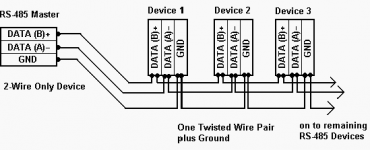TwoBlocked
Senior Member
- Location
- Bradford County, PA
- Occupation
- Industrial Electrician
Was looking at this drawing, doing some research, and considering how we are actually wiring devices. We use shielded, twisted pairs with a drain wire for DC power, analog signals, and RS485 communications. Often in a Teck cable bundle. At the field end, we snip and tape off the shield and drain wire as is recommended for analog signals. But am now understanding that for RS-485 it is recommended (required?) to provide a ground conductor, yet still ground the shield at only one end. To do this, you cannot use the drain as a ground. Still, we haven't been experiencing comm problems (that I know of...) by not wiring a dedicated, insulated ground. The devices themselves are grounded through the cable armor and fittings.
Any thoughts? Should we be using twisted 3 wire? (Probably, but that doesn't seem to be the typical way here...)

Any thoughts? Should we be using twisted 3 wire? (Probably, but that doesn't seem to be the typical way here...)


